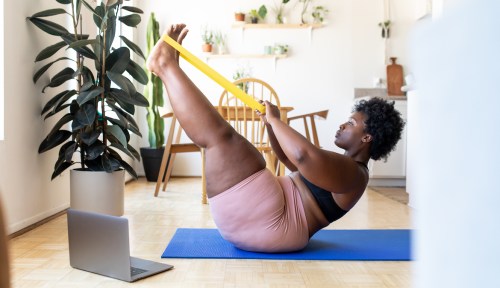Our editors independently select these products. Making a purchase through our links may earn Well+Good a commission
You don’t have to pick up something heavy to get a great strength workout. Yes, there are always bodyweight exercises, like push-ups or lunges, that will challenge your muscles. But one way to take it up a notch, protect your joints, and have a workout tool you can throw in a suitcase, is by using resistance bands.
Experts in This Article
certified personal trainer and signature guide at KINRGY
“Resistance bands work by offering an external force to the muscles without having to lift weights,” Alissa Tucker, CPT, CES, the master trainer of AKT, a cardio/dance workout that uses resistance bands hanging from the ceiling to engage your back and core muscles. “Like lifting weights, resistance bands can help to improve muscle endurance and strength, and strengthen connective tissue in the joints.” Yet they can be easier on the body, which is why many experts recommend resistance band exercises for seniors in particular.
Tucker explains that the power of the bands lies in their ability to increase “time under tension,” which is the length of time a muscle is working, either in the contracting (concentric) or lengthening (eccentric) phase. As you stretch a band in a move like a clamshell, the resistance of that band is prompting you to engage your muscles throughout the whole move, and especially at the end of the range of motion when there is the most resistance. Hence, greater time under tension!
There are a few types of resistance bands, including short loops, long loops, single strands with handles, and others. But the concept of providing a joint stress–free way to engage your muscles carries over from type to type.
How to make the most of resistance band workouts
To get everything you can out of a resistance band, there are some tips to keep in mind, especially if you’re a novice and are interested in trying out some resistance bands exercises for beginners. First up is moving through that full range of motion—even at its most challenging point.
“Because of the increase of intensity as you reach your full range of motion, a tendency can be to limit and not move through the full range,” Tucker says. Yet going all the way to your end point will help you maintain balance in the body, and get the most out of the workout.
Also crucial is choosing the right resistance band. To figure this out, pay attention to your form: “Choose a band level that is challenging, but that you can move through your full range of motion,” Tucker says. “If you’re not sure which level band to choose, we always recommend grabbing two. You can start with the heavier band and if/when you feel your form start to slip or that you’re cutting your range of motion short, switch to the lighter band.”
5 resistance band moves for a joint pain-free ‘time under tension’ workout
Ready to get started? Tucker has laid out some of her favorite resistance band moves that will work both your upper and lower body. You’ll need a band with handles for these exercises, and some places in your home or at the gym where you can securely anchor it. Tucker suggests doing 16 reps of each exercise, making sure to hit both sides on the single limb exercises, and doing each two to four times through for a great workout.
Quadruped kickback
This is a great way to add some extra resistance to a glute burnout. This move will work the glutes and the hamstrings.
- 1.Begin on hands and knees in a tabletop position, with hands under shoulders, knees under hips.
- 2.Loop the band around one foot and hold the handles in each hand.
- 3.Keep your foot flexed and leg externally rotated and kick straight back, fully extending the knee, feeling the tension in the band increase.
Over unders
- 1.Anchor the band by looping it around a secure object at about shoulder height.
- 2.Face away from the anchor and hold one handle in each hand with your hands by your hips. There should not be significant tension in the band (yet!)
- 3.Extend arms forward to chest height with the palms facing up working the biceps, then bend the elbows, bringing your hands toward your shoulders.
- 4.With your arms still bent, flip your palms down and then extend the arms straight forward at shoulder height working the chest.
- 5.As you bend the elbows, feel the back muscles engage.
Lat pull and press
This move works your latissimus dorsi muscles in your back.
- 1.Anchor the band overhead by looping it around a secure object.
- 2.Hold one handle in each hand and pull the elbows down with bent arms and palms facing out.
- 3.Extend arms back overhead, then press forward and down with straight arms.
- 4.Slowly and with control, extend arms back overhead.
Row
- 1.Anchor the band by looping it around a secure object at about shoulder height.
- 2.Face the anchor and hold one handle in each hand, standing far enough away from your anchor that there’s no slack in the band.
- 3.Pull the elbows back with palms facing in toward each other, bringing the handles toward your hips as your squeeze your back muscles, activating your rhomboids.
Tricep pulses
- 1.While standing in a split stance, place the center of the band under your front foot and hold one handle in each hand.
- 2.Extend arms by your side (around hip level) and hinge your body forward at a 45-degree angle. There should be light-to-moderate tension in the band.
- 3.Pulse the arms straight up with palms facing up (the resistance will increase!), trying to keep the bands from dropping below your hips.
Or follow along with this workout to get in a great resistance band session:
Sign Up for Our Daily Newsletter
Get all the latest in wellness, trends, food, fitness, beauty, and more delivered right to your inbox.
Got it, you've been added to our email list.











